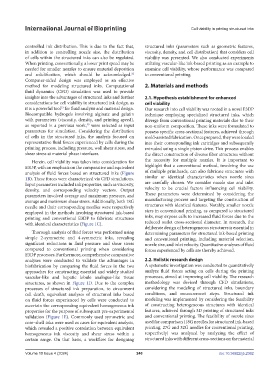Page 248 - IJB-10-4
P. 248
International Journal of Bioprinting Cell viability in printing structured inks
controlled ink distribution. This is due to the fact that, structured inks (parameters such as geometric features,
in addition to controlling nozzle size, the distribution viscosity, density, and cell distribution) that considers cell
of cells within the structured inks can also be regulated. viability was presented. We also conducted experiments
When printing, conventionally, a lower print speed may be utilizing vascular-like ink-based printing as an example to
needed for smaller nozzles to ensure material deposition examine cell viability, whose performance was compared
and solidification, which should be acknowledged. to conventional printing.
32
Computer-aided design was employed as an effective
method for modeling structured inks. Computational 2. Materials and methods
fluid dynamics (CFD) simulation was used to provide
insights into the advantages of structured inks and further 2.1. Hypothesis establishment for enhanced
considerations for cell viability in structured ink design, as cell viability
it is a powerful tool for fluid analysis and material design. Our research into cell viability was rooted in a novel E3DP
33
Biocompatible hydrogels involving alginate and gelatin technique employing specialized structured inks, which
with parameters (viscosity, density, and printing speed), diverge from conventional printing materials due to their
as reported in a previous work, were selected as input non-uniform composition. These inks were formulated to
30
parameters for simulation. Considering the distribution possess specific cross-sectional features, achieved through
of cells in the structured inks, the analysis focused on mold-assisted fabrication. Once prepared, they were loaded
representative fluid forces experienced by cells during the into their corresponding ink cartridges and subsequently
printing process, including pressure, wall shear stress, and extruded using a single piston drive. This process enables
shear stress at material phase interfaces. the direct construction of diverse fiber structures without
Herein, cell viability was taken into consideration for the necessity for multiple nozzles. It is important to
E3DP, with an emphasis on the comparative and equivalent highlight that a conventional method, involving the use
analysis of fluid forces based on structured inks (Figure of multiple printheads, can also fabricate structures with
1B). These forces were characterized via CFD simulations. similar or identical characteristics when nozzle sizes
Input parameters included ink properties, such as viscosity, are carefully chosen. We consider nozzle size and inlet
density, and corresponding velocity vectors. Output velocity to be crucial factors influencing cell viability.
parameters involved average and maximum pressure, and These parameters were determined by considering the
average and maximum shear stress. Additionally, both 18G manufacturing process and targeting the construction of
needle and their corresponding needles were respectively structures with identical features. Notably, smaller nozzle
employed in the methods involving structured ink-based sizes in conventional printing, as compared to structured
printing and conventional E3DP to fabricate structures inks, may expose cells to increased fluid forces due to the
with identical characteristics (Figure 1C). reduced outlet cross-sectional diameter. In research, the
deliberate design of heterogeneous structures is essential in
Thorough analysis of fluid forces was performed using determining parameters for structured ink-based printing
simple 2-symmetric and 4-symmetric inks, revealing and conventional printing, including material selection,
significant reductions in fluid pressure and shear stress nozzle size, and inlet velocity. Quantitative analyses of fluid
compared to conventional printing when considering forces experienced by cells are thereby achieved.
E3DP processes. Furthermore, comprehensive comparative
analyses were conducted to validate the advantages in 2.2. Holistic research design
biofabrication by comparing the fluid forces in the two A systematic investigation was conducted to quantitatively
approaches for constructing essential and widely studied analyze fluid forces acting on cells during the printing
vascular-like and hepatic lobule analogue-like tissue processes, aimed at improving cell viability. The research
structures, as shown in Figure 1D. Due to the complex methodology was devised through CFD simulations,
processes of structured ink preparation, to circumvent considering the modeling of structured inks, boundary
cell death, equivalent analyses of structured inks based conditions, and measurement steps. Structured ink
on fluid forces experienced by cells were conducted to modeling was implemented by considering the feasibility
ascertain the corresponding equivalent homogeneous ink of constructing heterogeneous structures with identical
properties for the purpose of subsequent pre-experimental features, achieved through 3D printing of structured inks
validation (Figure 1E). Commonly used symmetric and and conventional printing. The feasibility of nozzle sizes
core–shell inks were used as cases for equivalent analysis, used for comparison (18G needles for structured ink-based
which revealed a positive correlation between equivalent printing, 27G and 32G needles for conventional printing,
homogeneous ink viscosity and shear stress within a respectively) was analyzed by analyzing the effect of
certain range. On that basis, a workflow for designing structured inks with different cross-sections on the material
Volume 10 Issue 4 (2024) 240 doi: 10.36922/ijb.2362

